Accounting Principles: Financial Reporting and Ratio Analysis
VerifiedAdded on 2023/06/10
|22
|5533
|388
Report
AI Summary
This report provides a comprehensive analysis of accounting principles, focusing on financial statement preparation, ratio analysis, and the role of budgeting in organizational planning and control. It includes the creation of financial accounts for Ravan Ltd, a detailed ratio analysis of Digs Enterprise, and an examination of the purpose and scope of accounting in a complex business environment. The report also explores how accounting functions assist in making informed business decisions, meeting societal needs, and the main branches of accounting with required job skills. Furthermore, it evaluates the role of budgets in effective resource management, outlining budgetary control solutions to support organizational decision-making. This document is available on Desklib, a platform offering study tools and solved assignments for students.
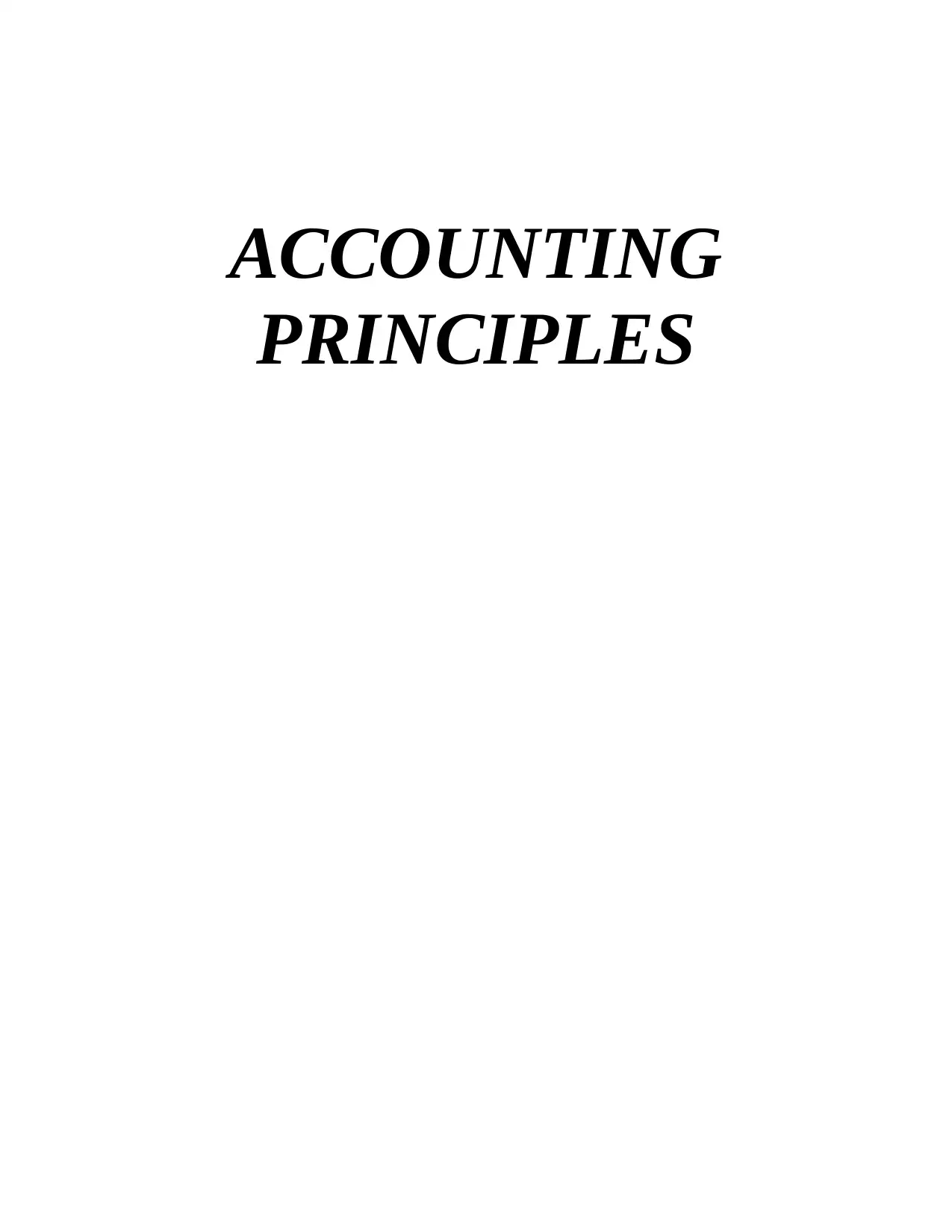
ACCOUNTING
PRINCIPLES
PRINCIPLES
Paraphrase This Document
Need a fresh take? Get an instant paraphrase of this document with our AI Paraphraser
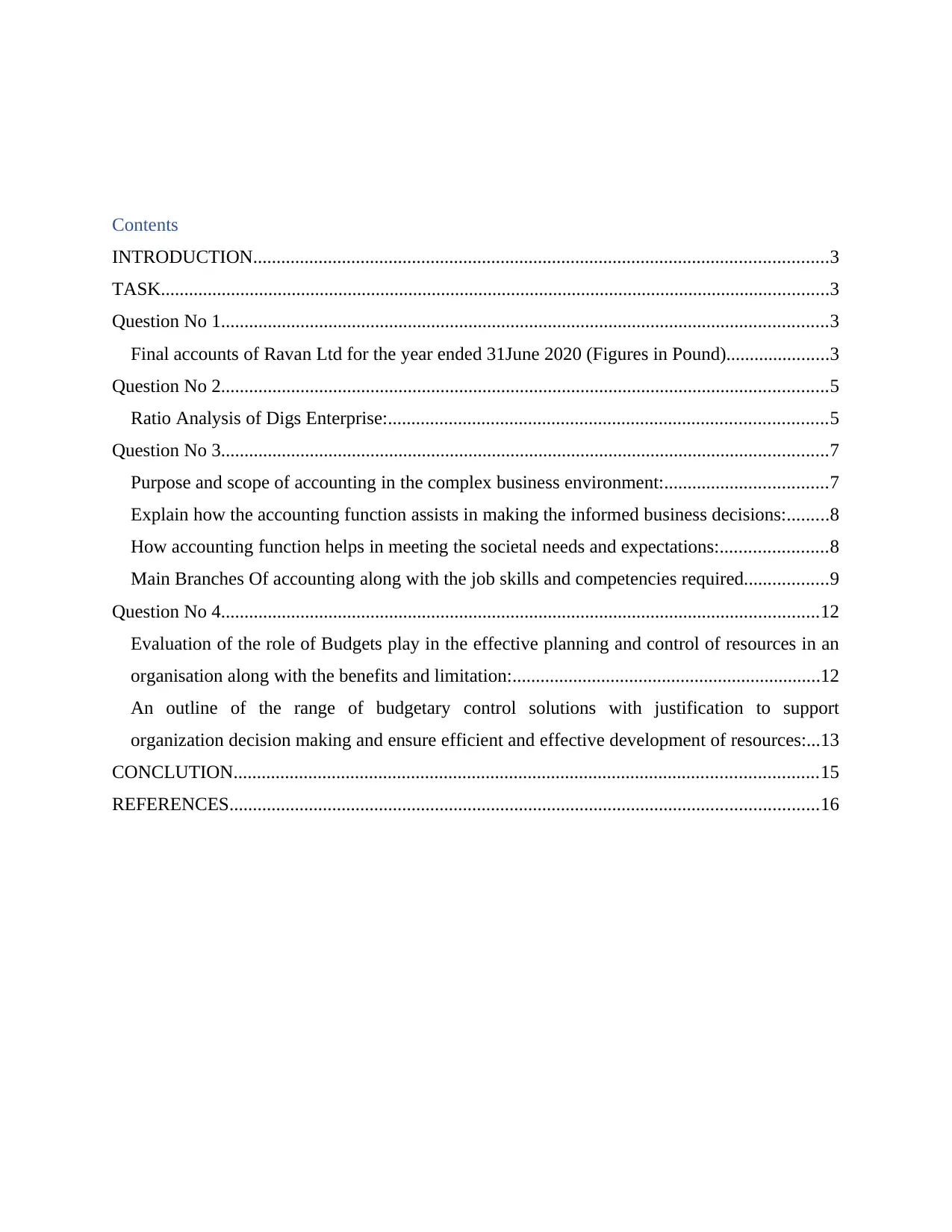
Contents
INTRODUCTION...........................................................................................................................3
TASK...............................................................................................................................................3
Question No 1..................................................................................................................................3
Final accounts of Ravan Ltd for the year ended 31June 2020 (Figures in Pound)......................3
Question No 2..................................................................................................................................5
Ratio Analysis of Digs Enterprise:..............................................................................................5
Question No 3..................................................................................................................................7
Purpose and scope of accounting in the complex business environment:...................................7
Explain how the accounting function assists in making the informed business decisions:.........8
How accounting function helps in meeting the societal needs and expectations:.......................8
Main Branches Of accounting along with the job skills and competencies required..................9
Question No 4................................................................................................................................12
Evaluation of the role of Budgets play in the effective planning and control of resources in an
organisation along with the benefits and limitation:..................................................................12
An outline of the range of budgetary control solutions with justification to support
organization decision making and ensure efficient and effective development of resources:...13
CONCLUTION.............................................................................................................................15
REFERENCES..............................................................................................................................16
INTRODUCTION...........................................................................................................................3
TASK...............................................................................................................................................3
Question No 1..................................................................................................................................3
Final accounts of Ravan Ltd for the year ended 31June 2020 (Figures in Pound)......................3
Question No 2..................................................................................................................................5
Ratio Analysis of Digs Enterprise:..............................................................................................5
Question No 3..................................................................................................................................7
Purpose and scope of accounting in the complex business environment:...................................7
Explain how the accounting function assists in making the informed business decisions:.........8
How accounting function helps in meeting the societal needs and expectations:.......................8
Main Branches Of accounting along with the job skills and competencies required..................9
Question No 4................................................................................................................................12
Evaluation of the role of Budgets play in the effective planning and control of resources in an
organisation along with the benefits and limitation:..................................................................12
An outline of the range of budgetary control solutions with justification to support
organization decision making and ensure efficient and effective development of resources:...13
CONCLUTION.............................................................................................................................15
REFERENCES..............................................................................................................................16
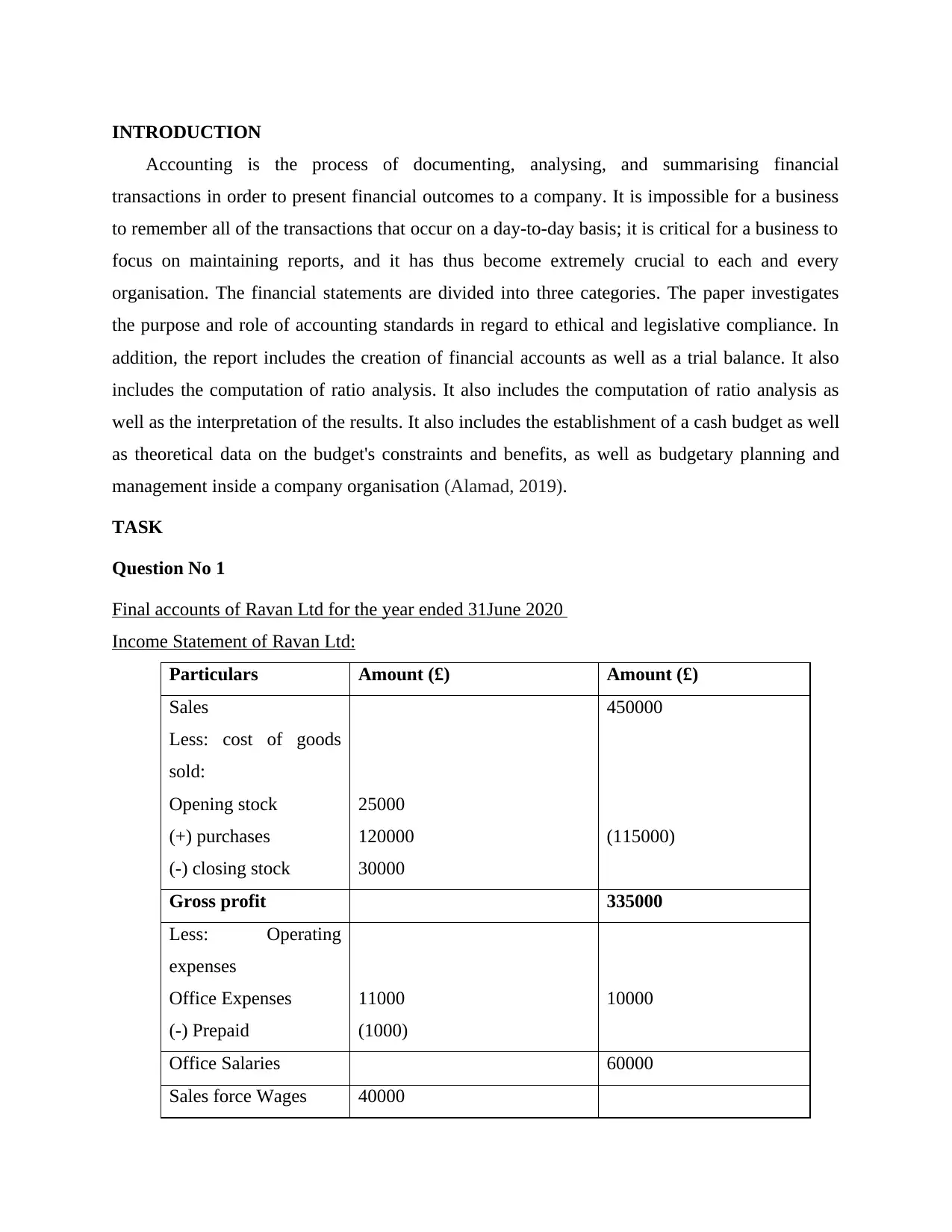
INTRODUCTION
Accounting is the process of documenting, analysing, and summarising financial
transactions in order to present financial outcomes to a company. It is impossible for a business
to remember all of the transactions that occur on a day-to-day basis; it is critical for a business to
focus on maintaining reports, and it has thus become extremely crucial to each and every
organisation. The financial statements are divided into three categories. The paper investigates
the purpose and role of accounting standards in regard to ethical and legislative compliance. In
addition, the report includes the creation of financial accounts as well as a trial balance. It also
includes the computation of ratio analysis. It also includes the computation of ratio analysis as
well as the interpretation of the results. It also includes the establishment of a cash budget as well
as theoretical data on the budget's constraints and benefits, as well as budgetary planning and
management inside a company organisation (Alamad, 2019).
TASK
Question No 1
Final accounts of Ravan Ltd for the year ended 31June 2020
Income Statement of Ravan Ltd:
Particulars Amount (£) Amount (£)
Sales
Less: cost of goods
sold:
Opening stock
(+) purchases
(-) closing stock
25000
120000
30000
450000
(115000)
Gross profit 335000
Less: Operating
expenses
Office Expenses
(-) Prepaid
11000
(1000)
10000
Office Salaries 60000
Sales force Wages 40000
Accounting is the process of documenting, analysing, and summarising financial
transactions in order to present financial outcomes to a company. It is impossible for a business
to remember all of the transactions that occur on a day-to-day basis; it is critical for a business to
focus on maintaining reports, and it has thus become extremely crucial to each and every
organisation. The financial statements are divided into three categories. The paper investigates
the purpose and role of accounting standards in regard to ethical and legislative compliance. In
addition, the report includes the creation of financial accounts as well as a trial balance. It also
includes the computation of ratio analysis. It also includes the computation of ratio analysis as
well as the interpretation of the results. It also includes the establishment of a cash budget as well
as theoretical data on the budget's constraints and benefits, as well as budgetary planning and
management inside a company organisation (Alamad, 2019).
TASK
Question No 1
Final accounts of Ravan Ltd for the year ended 31June 2020
Income Statement of Ravan Ltd:
Particulars Amount (£) Amount (£)
Sales
Less: cost of goods
sold:
Opening stock
(+) purchases
(-) closing stock
25000
120000
30000
450000
(115000)
Gross profit 335000
Less: Operating
expenses
Office Expenses
(-) Prepaid
11000
(1000)
10000
Office Salaries 60000
Sales force Wages 40000
⊘ This is a preview!⊘
Do you want full access?
Subscribe today to unlock all pages.

Trusted by 1+ million students worldwide

(+) Outstanding 2000 42000
Advertisement 6000
Communication
Expenses
2000
Director
Remuneration
80000
Interest Paid 600
Allowance for trade
receivables
15889.50
Depreciation on office
equipment @ 20%
51200
Total operating cost -267689.50
Net profit 67310.50
Less: Taxation 20000
Net profit after tax 63200
Less: Interim
Dividend Paid
4000
Net Profit after
dividend
43310.50
Statement of Financial Position of Ravan Ltd:
Current Assets Amount (£)
Non-Current Assets
Property, Plant and Equipment 204800
Total non-current assets 204800
Current Assets
Trade Receivables 518950
Inventories 30000
Advertisement 6000
Communication
Expenses
2000
Director
Remuneration
80000
Interest Paid 600
Allowance for trade
receivables
15889.50
Depreciation on office
equipment @ 20%
51200
Total operating cost -267689.50
Net profit 67310.50
Less: Taxation 20000
Net profit after tax 63200
Less: Interim
Dividend Paid
4000
Net Profit after
dividend
43310.50
Statement of Financial Position of Ravan Ltd:
Current Assets Amount (£)
Non-Current Assets
Property, Plant and Equipment 204800
Total non-current assets 204800
Current Assets
Trade Receivables 518950
Inventories 30000
Paraphrase This Document
Need a fresh take? Get an instant paraphrase of this document with our AI Paraphraser
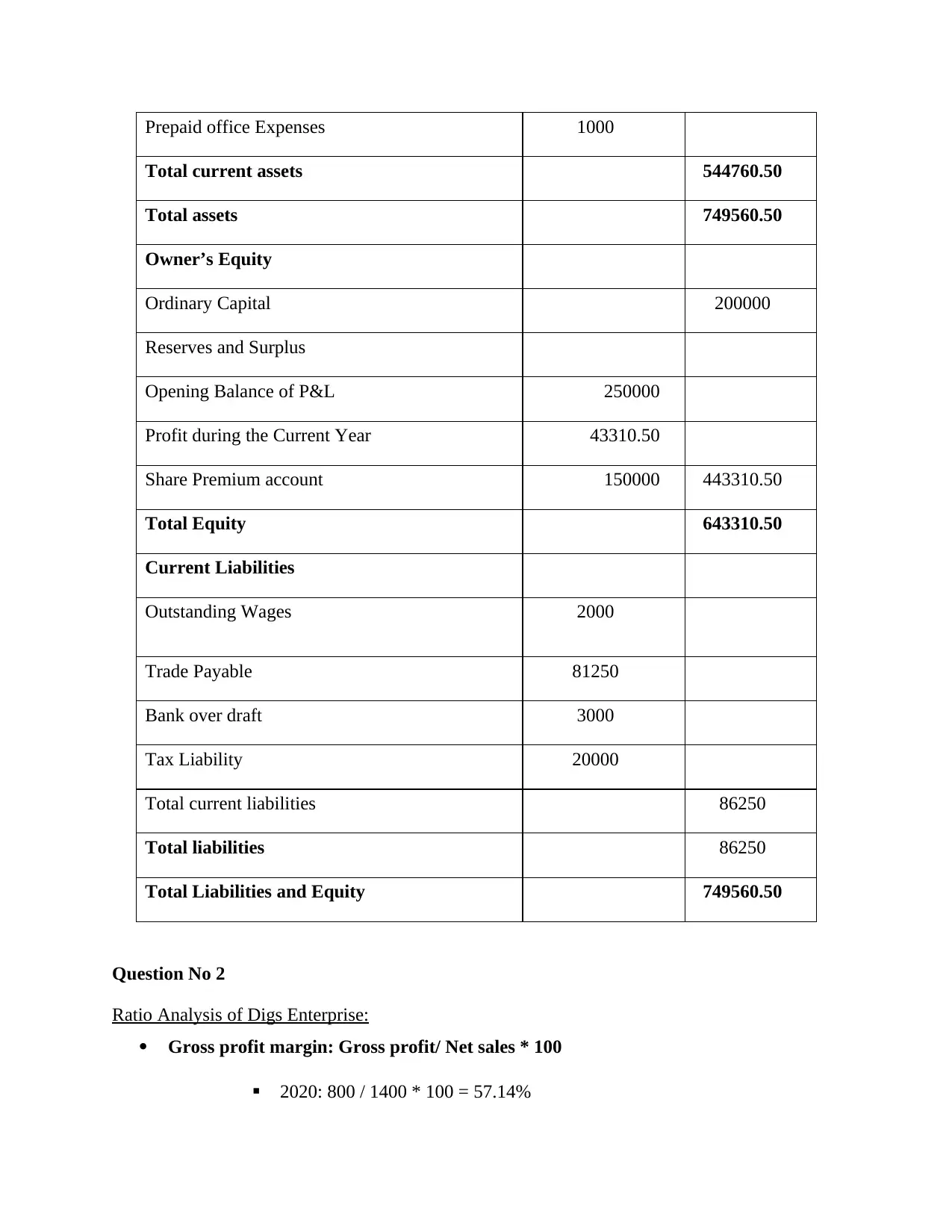
Prepaid office Expenses 1000
Total current assets 544760.50
Total assets 749560.50
Owner’s Equity
Ordinary Capital 200000
Reserves and Surplus
Opening Balance of P&L 250000
Profit during the Current Year 43310.50
Share Premium account 150000 443310.50
Total Equity 643310.50
Current Liabilities
Outstanding Wages 2000
Trade Payable 81250
Bank over draft 3000
Tax Liability 20000
Total current liabilities 86250
Total liabilities 86250
Total Liabilities and Equity 749560.50
Question No 2
Ratio Analysis of Digs Enterprise:
Gross profit margin: Gross profit/ Net sales * 100
2020: 800 / 1400 * 100 = 57.14%
Total current assets 544760.50
Total assets 749560.50
Owner’s Equity
Ordinary Capital 200000
Reserves and Surplus
Opening Balance of P&L 250000
Profit during the Current Year 43310.50
Share Premium account 150000 443310.50
Total Equity 643310.50
Current Liabilities
Outstanding Wages 2000
Trade Payable 81250
Bank over draft 3000
Tax Liability 20000
Total current liabilities 86250
Total liabilities 86250
Total Liabilities and Equity 749560.50
Question No 2
Ratio Analysis of Digs Enterprise:
Gross profit margin: Gross profit/ Net sales * 100
2020: 800 / 1400 * 100 = 57.14%
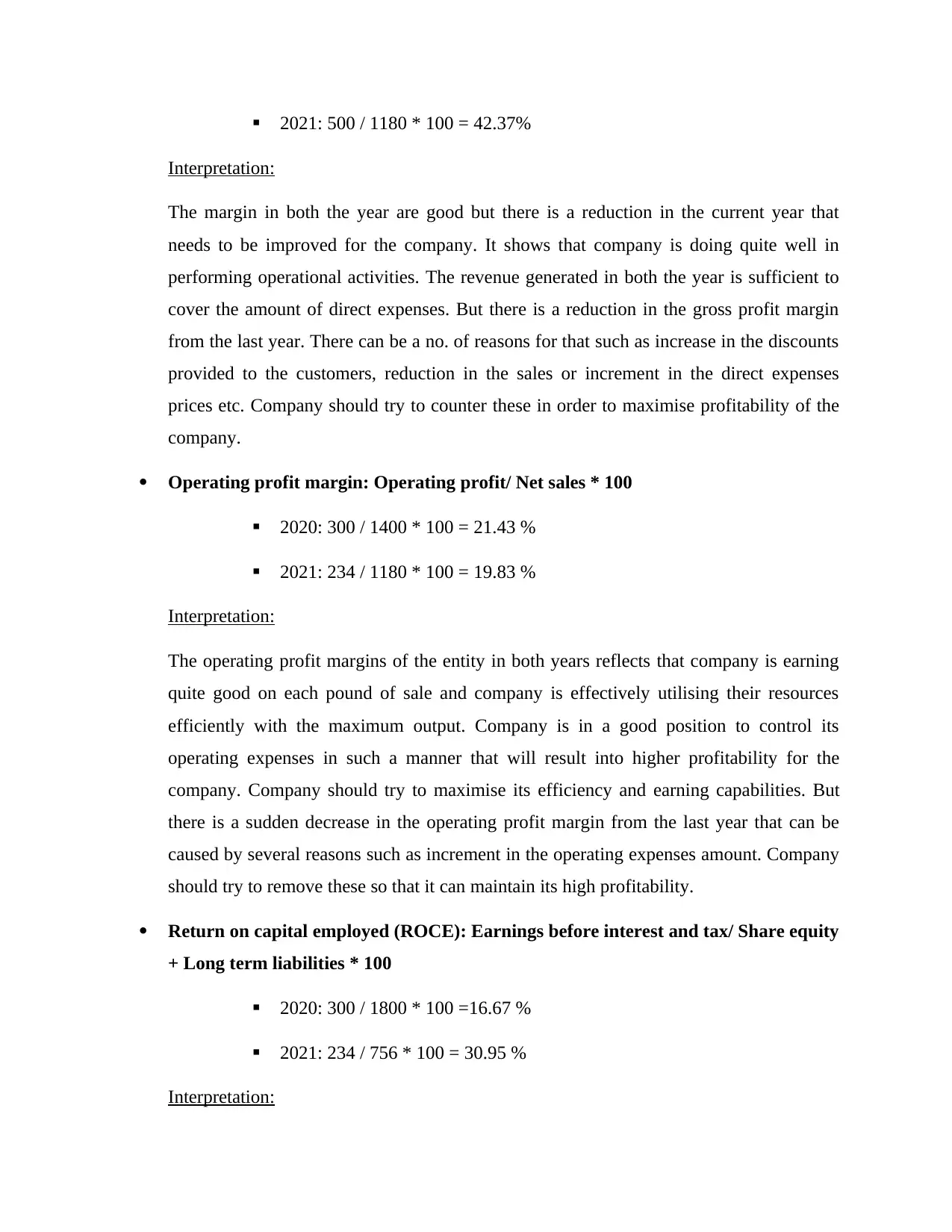
2021: 500 / 1180 * 100 = 42.37%
Interpretation:
The margin in both the year are good but there is a reduction in the current year that
needs to be improved for the company. It shows that company is doing quite well in
performing operational activities. The revenue generated in both the year is sufficient to
cover the amount of direct expenses. But there is a reduction in the gross profit margin
from the last year. There can be a no. of reasons for that such as increase in the discounts
provided to the customers, reduction in the sales or increment in the direct expenses
prices etc. Company should try to counter these in order to maximise profitability of the
company.
Operating profit margin: Operating profit/ Net sales * 100
2020: 300 / 1400 * 100 = 21.43 %
2021: 234 / 1180 * 100 = 19.83 %
Interpretation:
The operating profit margins of the entity in both years reflects that company is earning
quite good on each pound of sale and company is effectively utilising their resources
efficiently with the maximum output. Company is in a good position to control its
operating expenses in such a manner that will result into higher profitability for the
company. Company should try to maximise its efficiency and earning capabilities. But
there is a sudden decrease in the operating profit margin from the last year that can be
caused by several reasons such as increment in the operating expenses amount. Company
should try to remove these so that it can maintain its high profitability.
Return on capital employed (ROCE): Earnings before interest and tax/ Share equity
+ Long term liabilities * 100
2020: 300 / 1800 * 100 =16.67 %
2021: 234 / 756 * 100 = 30.95 %
Interpretation:
Interpretation:
The margin in both the year are good but there is a reduction in the current year that
needs to be improved for the company. It shows that company is doing quite well in
performing operational activities. The revenue generated in both the year is sufficient to
cover the amount of direct expenses. But there is a reduction in the gross profit margin
from the last year. There can be a no. of reasons for that such as increase in the discounts
provided to the customers, reduction in the sales or increment in the direct expenses
prices etc. Company should try to counter these in order to maximise profitability of the
company.
Operating profit margin: Operating profit/ Net sales * 100
2020: 300 / 1400 * 100 = 21.43 %
2021: 234 / 1180 * 100 = 19.83 %
Interpretation:
The operating profit margins of the entity in both years reflects that company is earning
quite good on each pound of sale and company is effectively utilising their resources
efficiently with the maximum output. Company is in a good position to control its
operating expenses in such a manner that will result into higher profitability for the
company. Company should try to maximise its efficiency and earning capabilities. But
there is a sudden decrease in the operating profit margin from the last year that can be
caused by several reasons such as increment in the operating expenses amount. Company
should try to remove these so that it can maintain its high profitability.
Return on capital employed (ROCE): Earnings before interest and tax/ Share equity
+ Long term liabilities * 100
2020: 300 / 1800 * 100 =16.67 %
2021: 234 / 756 * 100 = 30.95 %
Interpretation:
⊘ This is a preview!⊘
Do you want full access?
Subscribe today to unlock all pages.

Trusted by 1+ million students worldwide
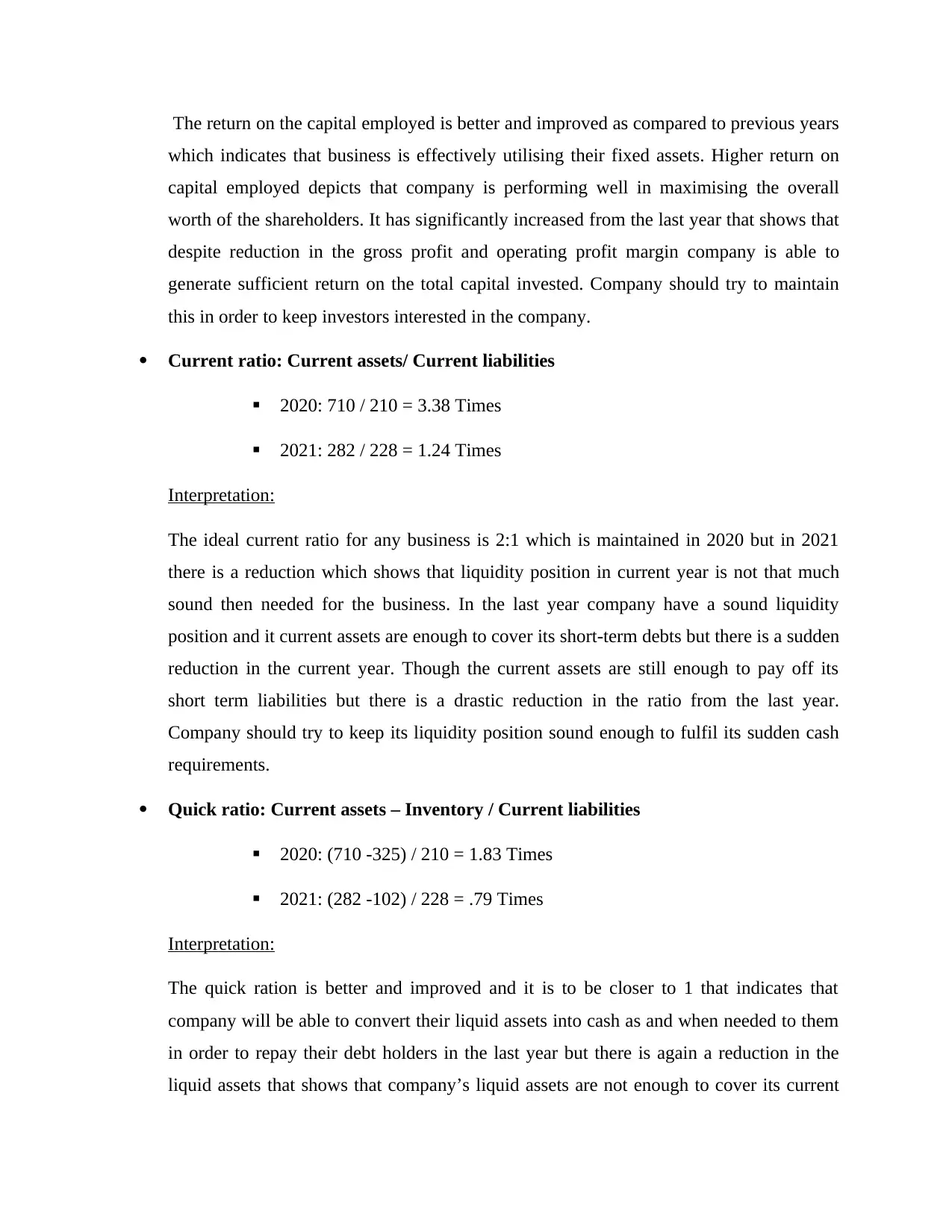
The return on the capital employed is better and improved as compared to previous years
which indicates that business is effectively utilising their fixed assets. Higher return on
capital employed depicts that company is performing well in maximising the overall
worth of the shareholders. It has significantly increased from the last year that shows that
despite reduction in the gross profit and operating profit margin company is able to
generate sufficient return on the total capital invested. Company should try to maintain
this in order to keep investors interested in the company.
Current ratio: Current assets/ Current liabilities
2020: 710 / 210 = 3.38 Times
2021: 282 / 228 = 1.24 Times
Interpretation:
The ideal current ratio for any business is 2:1 which is maintained in 2020 but in 2021
there is a reduction which shows that liquidity position in current year is not that much
sound then needed for the business. In the last year company have a sound liquidity
position and it current assets are enough to cover its short-term debts but there is a sudden
reduction in the current year. Though the current assets are still enough to pay off its
short term liabilities but there is a drastic reduction in the ratio from the last year.
Company should try to keep its liquidity position sound enough to fulfil its sudden cash
requirements.
Quick ratio: Current assets – Inventory / Current liabilities
2020: (710 -325) / 210 = 1.83 Times
2021: (282 -102) / 228 = .79 Times
Interpretation:
The quick ration is better and improved and it is to be closer to 1 that indicates that
company will be able to convert their liquid assets into cash as and when needed to them
in order to repay their debt holders in the last year but there is again a reduction in the
liquid assets that shows that company’s liquid assets are not enough to cover its current
which indicates that business is effectively utilising their fixed assets. Higher return on
capital employed depicts that company is performing well in maximising the overall
worth of the shareholders. It has significantly increased from the last year that shows that
despite reduction in the gross profit and operating profit margin company is able to
generate sufficient return on the total capital invested. Company should try to maintain
this in order to keep investors interested in the company.
Current ratio: Current assets/ Current liabilities
2020: 710 / 210 = 3.38 Times
2021: 282 / 228 = 1.24 Times
Interpretation:
The ideal current ratio for any business is 2:1 which is maintained in 2020 but in 2021
there is a reduction which shows that liquidity position in current year is not that much
sound then needed for the business. In the last year company have a sound liquidity
position and it current assets are enough to cover its short-term debts but there is a sudden
reduction in the current year. Though the current assets are still enough to pay off its
short term liabilities but there is a drastic reduction in the ratio from the last year.
Company should try to keep its liquidity position sound enough to fulfil its sudden cash
requirements.
Quick ratio: Current assets – Inventory / Current liabilities
2020: (710 -325) / 210 = 1.83 Times
2021: (282 -102) / 228 = .79 Times
Interpretation:
The quick ration is better and improved and it is to be closer to 1 that indicates that
company will be able to convert their liquid assets into cash as and when needed to them
in order to repay their debt holders in the last year but there is again a reduction in the
liquid assets that shows that company’s liquid assets are not enough to cover its current
Paraphrase This Document
Need a fresh take? Get an instant paraphrase of this document with our AI Paraphraser
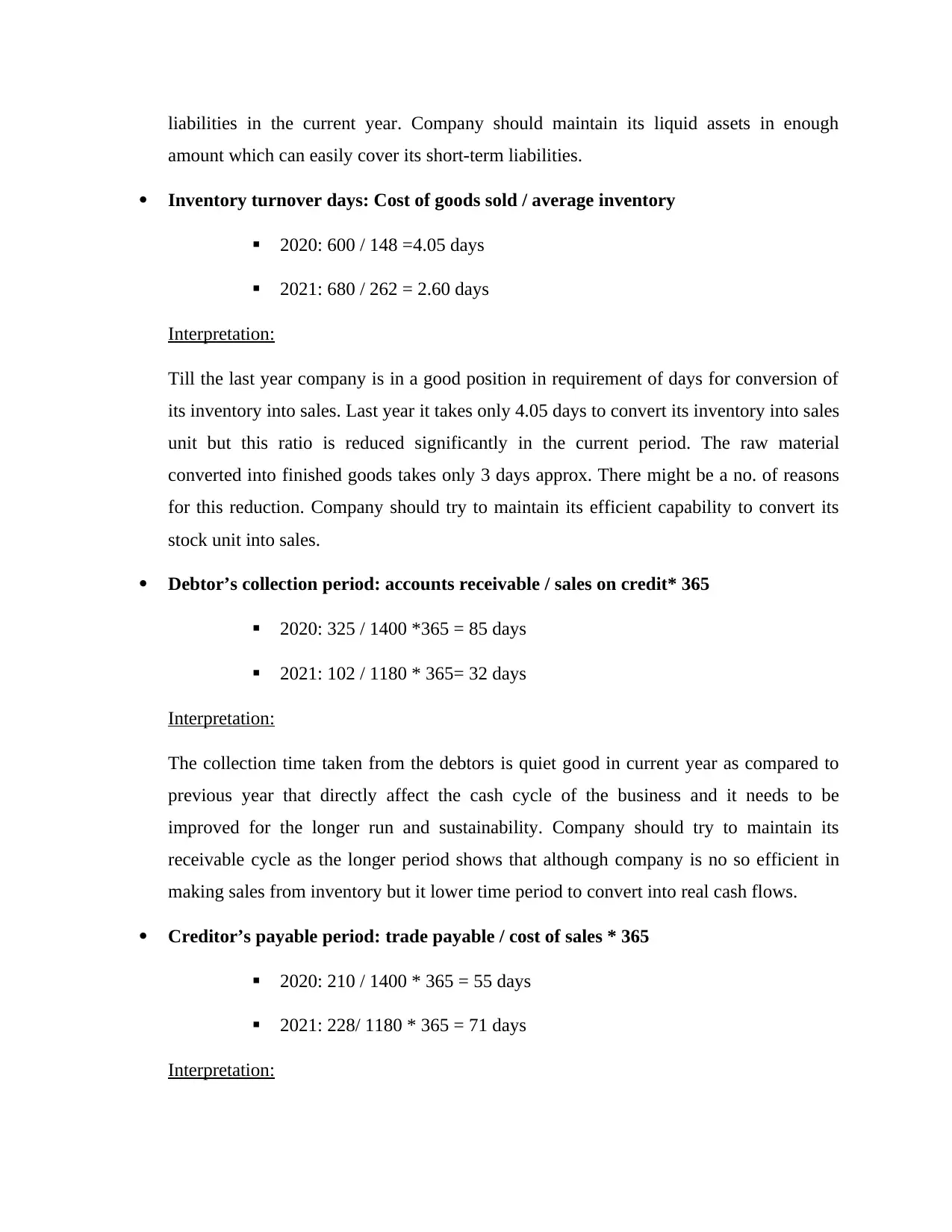
liabilities in the current year. Company should maintain its liquid assets in enough
amount which can easily cover its short-term liabilities.
Inventory turnover days: Cost of goods sold / average inventory
2020: 600 / 148 =4.05 days
2021: 680 / 262 = 2.60 days
Interpretation:
Till the last year company is in a good position in requirement of days for conversion of
its inventory into sales. Last year it takes only 4.05 days to convert its inventory into sales
unit but this ratio is reduced significantly in the current period. The raw material
converted into finished goods takes only 3 days approx. There might be a no. of reasons
for this reduction. Company should try to maintain its efficient capability to convert its
stock unit into sales.
Debtor’s collection period: accounts receivable / sales on credit* 365
2020: 325 / 1400 *365 = 85 days
2021: 102 / 1180 * 365= 32 days
Interpretation:
The collection time taken from the debtors is quiet good in current year as compared to
previous year that directly affect the cash cycle of the business and it needs to be
improved for the longer run and sustainability. Company should try to maintain its
receivable cycle as the longer period shows that although company is no so efficient in
making sales from inventory but it lower time period to convert into real cash flows.
Creditor’s payable period: trade payable / cost of sales * 365
2020: 210 / 1400 * 365 = 55 days
2021: 228/ 1180 * 365 = 71 days
Interpretation:
amount which can easily cover its short-term liabilities.
Inventory turnover days: Cost of goods sold / average inventory
2020: 600 / 148 =4.05 days
2021: 680 / 262 = 2.60 days
Interpretation:
Till the last year company is in a good position in requirement of days for conversion of
its inventory into sales. Last year it takes only 4.05 days to convert its inventory into sales
unit but this ratio is reduced significantly in the current period. The raw material
converted into finished goods takes only 3 days approx. There might be a no. of reasons
for this reduction. Company should try to maintain its efficient capability to convert its
stock unit into sales.
Debtor’s collection period: accounts receivable / sales on credit* 365
2020: 325 / 1400 *365 = 85 days
2021: 102 / 1180 * 365= 32 days
Interpretation:
The collection time taken from the debtors is quiet good in current year as compared to
previous year that directly affect the cash cycle of the business and it needs to be
improved for the longer run and sustainability. Company should try to maintain its
receivable cycle as the longer period shows that although company is no so efficient in
making sales from inventory but it lower time period to convert into real cash flows.
Creditor’s payable period: trade payable / cost of sales * 365
2020: 210 / 1400 * 365 = 55 days
2021: 228/ 1180 * 365 = 71 days
Interpretation:
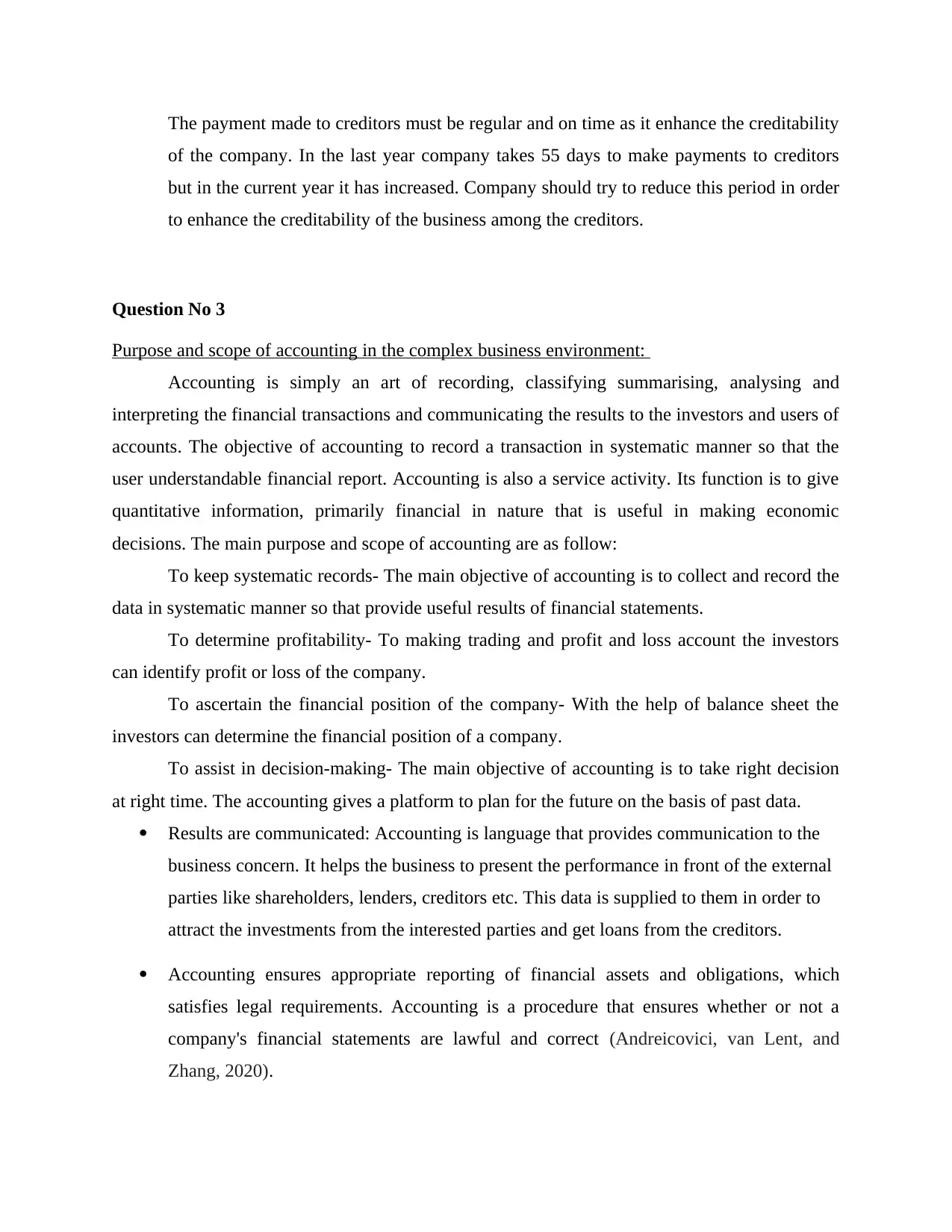
The payment made to creditors must be regular and on time as it enhance the creditability
of the company. In the last year company takes 55 days to make payments to creditors
but in the current year it has increased. Company should try to reduce this period in order
to enhance the creditability of the business among the creditors.
Question No 3
Purpose and scope of accounting in the complex business environment:
Accounting is simply an art of recording, classifying summarising, analysing and
interpreting the financial transactions and communicating the results to the investors and users of
accounts. The objective of accounting to record a transaction in systematic manner so that the
user understandable financial report. Accounting is also a service activity. Its function is to give
quantitative information, primarily financial in nature that is useful in making economic
decisions. The main purpose and scope of accounting are as follow:
To keep systematic records- The main objective of accounting is to collect and record the
data in systematic manner so that provide useful results of financial statements.
To determine profitability- To making trading and profit and loss account the investors
can identify profit or loss of the company.
To ascertain the financial position of the company- With the help of balance sheet the
investors can determine the financial position of a company.
To assist in decision-making- The main objective of accounting is to take right decision
at right time. The accounting gives a platform to plan for the future on the basis of past data.
Results are communicated: Accounting is language that provides communication to the
business concern. It helps the business to present the performance in front of the external
parties like shareholders, lenders, creditors etc. This data is supplied to them in order to
attract the investments from the interested parties and get loans from the creditors.
Accounting ensures appropriate reporting of financial assets and obligations, which
satisfies legal requirements. Accounting is a procedure that ensures whether or not a
company's financial statements are lawful and correct (Andreicovici, van Lent, and
Zhang, 2020).
of the company. In the last year company takes 55 days to make payments to creditors
but in the current year it has increased. Company should try to reduce this period in order
to enhance the creditability of the business among the creditors.
Question No 3
Purpose and scope of accounting in the complex business environment:
Accounting is simply an art of recording, classifying summarising, analysing and
interpreting the financial transactions and communicating the results to the investors and users of
accounts. The objective of accounting to record a transaction in systematic manner so that the
user understandable financial report. Accounting is also a service activity. Its function is to give
quantitative information, primarily financial in nature that is useful in making economic
decisions. The main purpose and scope of accounting are as follow:
To keep systematic records- The main objective of accounting is to collect and record the
data in systematic manner so that provide useful results of financial statements.
To determine profitability- To making trading and profit and loss account the investors
can identify profit or loss of the company.
To ascertain the financial position of the company- With the help of balance sheet the
investors can determine the financial position of a company.
To assist in decision-making- The main objective of accounting is to take right decision
at right time. The accounting gives a platform to plan for the future on the basis of past data.
Results are communicated: Accounting is language that provides communication to the
business concern. It helps the business to present the performance in front of the external
parties like shareholders, lenders, creditors etc. This data is supplied to them in order to
attract the investments from the interested parties and get loans from the creditors.
Accounting ensures appropriate reporting of financial assets and obligations, which
satisfies legal requirements. Accounting is a procedure that ensures whether or not a
company's financial statements are lawful and correct (Andreicovici, van Lent, and
Zhang, 2020).
⊘ This is a preview!⊘
Do you want full access?
Subscribe today to unlock all pages.

Trusted by 1+ million students worldwide
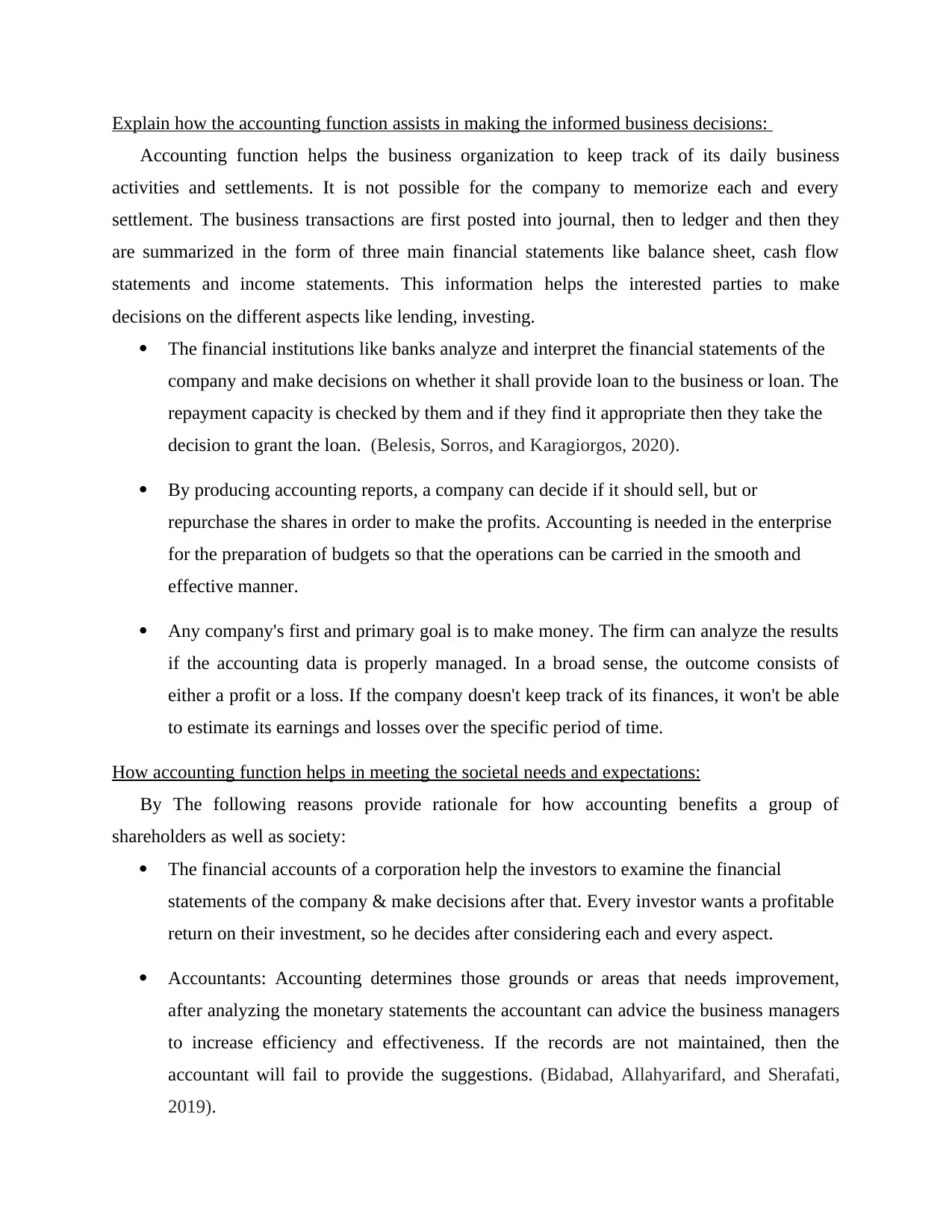
Explain how the accounting function assists in making the informed business decisions:
Accounting function helps the business organization to keep track of its daily business
activities and settlements. It is not possible for the company to memorize each and every
settlement. The business transactions are first posted into journal, then to ledger and then they
are summarized in the form of three main financial statements like balance sheet, cash flow
statements and income statements. This information helps the interested parties to make
decisions on the different aspects like lending, investing.
The financial institutions like banks analyze and interpret the financial statements of the
company and make decisions on whether it shall provide loan to the business or loan. The
repayment capacity is checked by them and if they find it appropriate then they take the
decision to grant the loan. (Belesis, Sorros, and Karagiorgos, 2020).
By producing accounting reports, a company can decide if it should sell, but or
repurchase the shares in order to make the profits. Accounting is needed in the enterprise
for the preparation of budgets so that the operations can be carried in the smooth and
effective manner.
Any company's first and primary goal is to make money. The firm can analyze the results
if the accounting data is properly managed. In a broad sense, the outcome consists of
either a profit or a loss. If the company doesn't keep track of its finances, it won't be able
to estimate its earnings and losses over the specific period of time.
How accounting function helps in meeting the societal needs and expectations:
By The following reasons provide rationale for how accounting benefits a group of
shareholders as well as society:
The financial accounts of a corporation help the investors to examine the financial
statements of the company & make decisions after that. Every investor wants a profitable
return on their investment, so he decides after considering each and every aspect.
Accountants: Accounting determines those grounds or areas that needs improvement,
after analyzing the monetary statements the accountant can advice the business managers
to increase efficiency and effectiveness. If the records are not maintained, then the
accountant will fail to provide the suggestions. (Bidabad, Allahyarifard, and Sherafati,
2019).
Accounting function helps the business organization to keep track of its daily business
activities and settlements. It is not possible for the company to memorize each and every
settlement. The business transactions are first posted into journal, then to ledger and then they
are summarized in the form of three main financial statements like balance sheet, cash flow
statements and income statements. This information helps the interested parties to make
decisions on the different aspects like lending, investing.
The financial institutions like banks analyze and interpret the financial statements of the
company and make decisions on whether it shall provide loan to the business or loan. The
repayment capacity is checked by them and if they find it appropriate then they take the
decision to grant the loan. (Belesis, Sorros, and Karagiorgos, 2020).
By producing accounting reports, a company can decide if it should sell, but or
repurchase the shares in order to make the profits. Accounting is needed in the enterprise
for the preparation of budgets so that the operations can be carried in the smooth and
effective manner.
Any company's first and primary goal is to make money. The firm can analyze the results
if the accounting data is properly managed. In a broad sense, the outcome consists of
either a profit or a loss. If the company doesn't keep track of its finances, it won't be able
to estimate its earnings and losses over the specific period of time.
How accounting function helps in meeting the societal needs and expectations:
By The following reasons provide rationale for how accounting benefits a group of
shareholders as well as society:
The financial accounts of a corporation help the investors to examine the financial
statements of the company & make decisions after that. Every investor wants a profitable
return on their investment, so he decides after considering each and every aspect.
Accountants: Accounting determines those grounds or areas that needs improvement,
after analyzing the monetary statements the accountant can advice the business managers
to increase efficiency and effectiveness. If the records are not maintained, then the
accountant will fail to provide the suggestions. (Bidabad, Allahyarifard, and Sherafati,
2019).
Paraphrase This Document
Need a fresh take? Get an instant paraphrase of this document with our AI Paraphraser
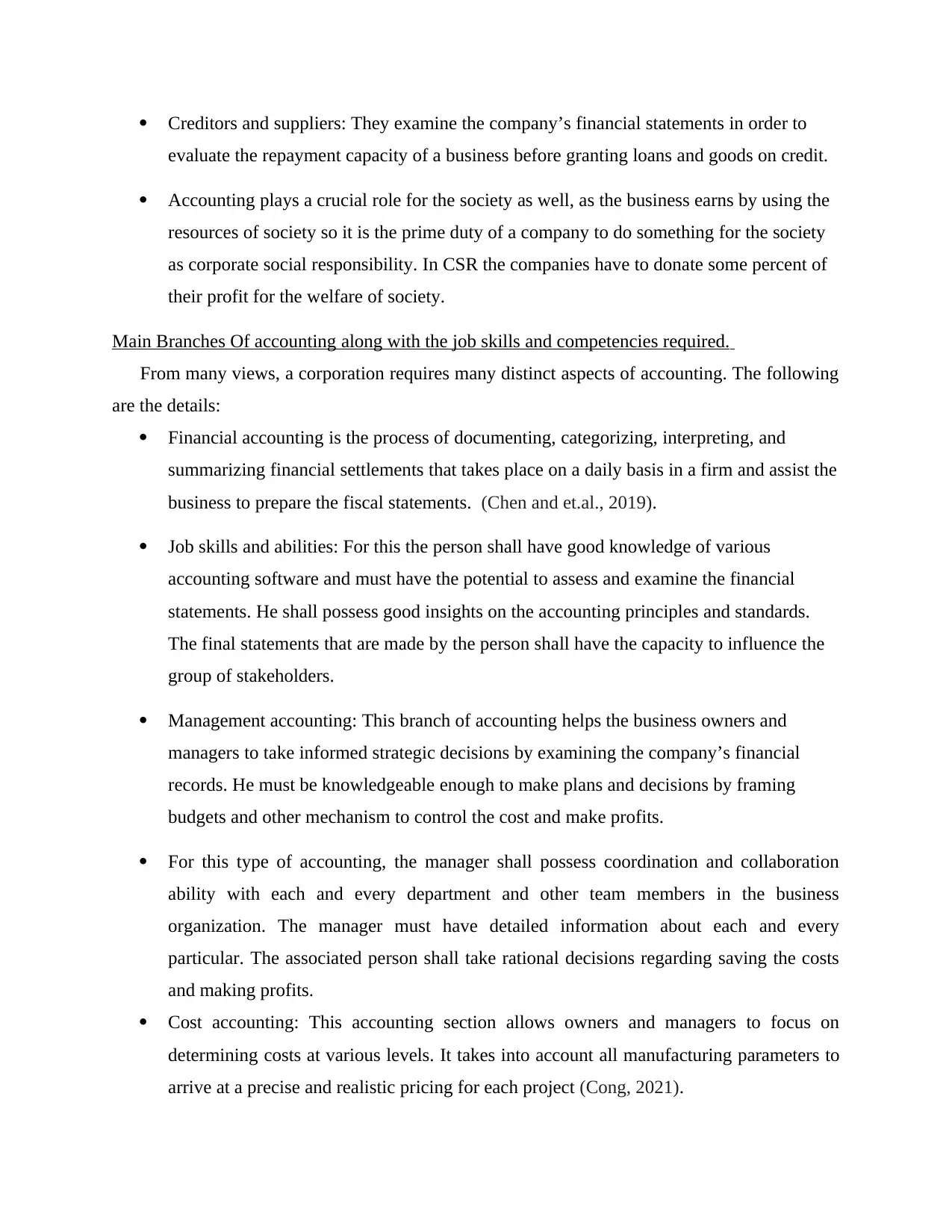
Creditors and suppliers: They examine the company’s financial statements in order to
evaluate the repayment capacity of a business before granting loans and goods on credit.
Accounting plays a crucial role for the society as well, as the business earns by using the
resources of society so it is the prime duty of a company to do something for the society
as corporate social responsibility. In CSR the companies have to donate some percent of
their profit for the welfare of society.
Main Branches Of accounting along with the job skills and competencies required.
From many views, a corporation requires many distinct aspects of accounting. The following
are the details:
Financial accounting is the process of documenting, categorizing, interpreting, and
summarizing financial settlements that takes place on a daily basis in a firm and assist the
business to prepare the fiscal statements. (Chen and et.al., 2019).
Job skills and abilities: For this the person shall have good knowledge of various
accounting software and must have the potential to assess and examine the financial
statements. He shall possess good insights on the accounting principles and standards.
The final statements that are made by the person shall have the capacity to influence the
group of stakeholders.
Management accounting: This branch of accounting helps the business owners and
managers to take informed strategic decisions by examining the company’s financial
records. He must be knowledgeable enough to make plans and decisions by framing
budgets and other mechanism to control the cost and make profits.
For this type of accounting, the manager shall possess coordination and collaboration
ability with each and every department and other team members in the business
organization. The manager must have detailed information about each and every
particular. The associated person shall take rational decisions regarding saving the costs
and making profits.
Cost accounting: This accounting section allows owners and managers to focus on
determining costs at various levels. It takes into account all manufacturing parameters to
arrive at a precise and realistic pricing for each project (Cong, 2021).
evaluate the repayment capacity of a business before granting loans and goods on credit.
Accounting plays a crucial role for the society as well, as the business earns by using the
resources of society so it is the prime duty of a company to do something for the society
as corporate social responsibility. In CSR the companies have to donate some percent of
their profit for the welfare of society.
Main Branches Of accounting along with the job skills and competencies required.
From many views, a corporation requires many distinct aspects of accounting. The following
are the details:
Financial accounting is the process of documenting, categorizing, interpreting, and
summarizing financial settlements that takes place on a daily basis in a firm and assist the
business to prepare the fiscal statements. (Chen and et.al., 2019).
Job skills and abilities: For this the person shall have good knowledge of various
accounting software and must have the potential to assess and examine the financial
statements. He shall possess good insights on the accounting principles and standards.
The final statements that are made by the person shall have the capacity to influence the
group of stakeholders.
Management accounting: This branch of accounting helps the business owners and
managers to take informed strategic decisions by examining the company’s financial
records. He must be knowledgeable enough to make plans and decisions by framing
budgets and other mechanism to control the cost and make profits.
For this type of accounting, the manager shall possess coordination and collaboration
ability with each and every department and other team members in the business
organization. The manager must have detailed information about each and every
particular. The associated person shall take rational decisions regarding saving the costs
and making profits.
Cost accounting: This accounting section allows owners and managers to focus on
determining costs at various levels. It takes into account all manufacturing parameters to
arrive at a precise and realistic pricing for each project (Cong, 2021).
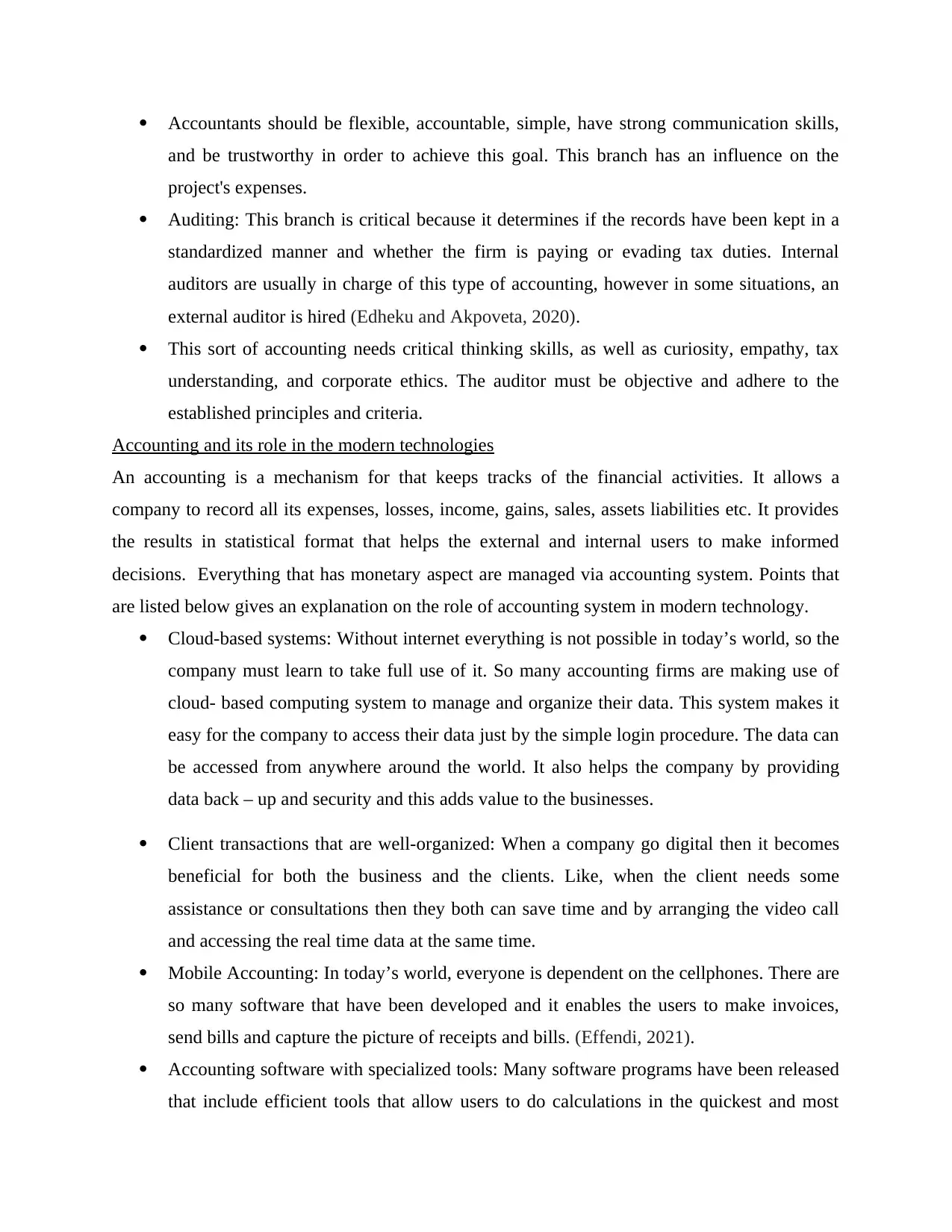
Accountants should be flexible, accountable, simple, have strong communication skills,
and be trustworthy in order to achieve this goal. This branch has an influence on the
project's expenses.
Auditing: This branch is critical because it determines if the records have been kept in a
standardized manner and whether the firm is paying or evading tax duties. Internal
auditors are usually in charge of this type of accounting, however in some situations, an
external auditor is hired (Edheku and Akpoveta, 2020).
This sort of accounting needs critical thinking skills, as well as curiosity, empathy, tax
understanding, and corporate ethics. The auditor must be objective and adhere to the
established principles and criteria.
Accounting and its role in the modern technologies
An accounting is a mechanism for that keeps tracks of the financial activities. It allows a
company to record all its expenses, losses, income, gains, sales, assets liabilities etc. It provides
the results in statistical format that helps the external and internal users to make informed
decisions. Everything that has monetary aspect are managed via accounting system. Points that
are listed below gives an explanation on the role of accounting system in modern technology.
Cloud-based systems: Without internet everything is not possible in today’s world, so the
company must learn to take full use of it. So many accounting firms are making use of
cloud- based computing system to manage and organize their data. This system makes it
easy for the company to access their data just by the simple login procedure. The data can
be accessed from anywhere around the world. It also helps the company by providing
data back – up and security and this adds value to the businesses.
Client transactions that are well-organized: When a company go digital then it becomes
beneficial for both the business and the clients. Like, when the client needs some
assistance or consultations then they both can save time and by arranging the video call
and accessing the real time data at the same time.
Mobile Accounting: In today’s world, everyone is dependent on the cellphones. There are
so many software that have been developed and it enables the users to make invoices,
send bills and capture the picture of receipts and bills. (Effendi, 2021).
Accounting software with specialized tools: Many software programs have been released
that include efficient tools that allow users to do calculations in the quickest and most
and be trustworthy in order to achieve this goal. This branch has an influence on the
project's expenses.
Auditing: This branch is critical because it determines if the records have been kept in a
standardized manner and whether the firm is paying or evading tax duties. Internal
auditors are usually in charge of this type of accounting, however in some situations, an
external auditor is hired (Edheku and Akpoveta, 2020).
This sort of accounting needs critical thinking skills, as well as curiosity, empathy, tax
understanding, and corporate ethics. The auditor must be objective and adhere to the
established principles and criteria.
Accounting and its role in the modern technologies
An accounting is a mechanism for that keeps tracks of the financial activities. It allows a
company to record all its expenses, losses, income, gains, sales, assets liabilities etc. It provides
the results in statistical format that helps the external and internal users to make informed
decisions. Everything that has monetary aspect are managed via accounting system. Points that
are listed below gives an explanation on the role of accounting system in modern technology.
Cloud-based systems: Without internet everything is not possible in today’s world, so the
company must learn to take full use of it. So many accounting firms are making use of
cloud- based computing system to manage and organize their data. This system makes it
easy for the company to access their data just by the simple login procedure. The data can
be accessed from anywhere around the world. It also helps the company by providing
data back – up and security and this adds value to the businesses.
Client transactions that are well-organized: When a company go digital then it becomes
beneficial for both the business and the clients. Like, when the client needs some
assistance or consultations then they both can save time and by arranging the video call
and accessing the real time data at the same time.
Mobile Accounting: In today’s world, everyone is dependent on the cellphones. There are
so many software that have been developed and it enables the users to make invoices,
send bills and capture the picture of receipts and bills. (Effendi, 2021).
Accounting software with specialized tools: Many software programs have been released
that include efficient tools that allow users to do calculations in the quickest and most
⊘ This is a preview!⊘
Do you want full access?
Subscribe today to unlock all pages.

Trusted by 1+ million students worldwide
1 out of 22
Related Documents
Your All-in-One AI-Powered Toolkit for Academic Success.
+13062052269
info@desklib.com
Available 24*7 on WhatsApp / Email
![[object Object]](/_next/static/media/star-bottom.7253800d.svg)
Unlock your academic potential
Copyright © 2020–2026 A2Z Services. All Rights Reserved. Developed and managed by ZUCOL.





